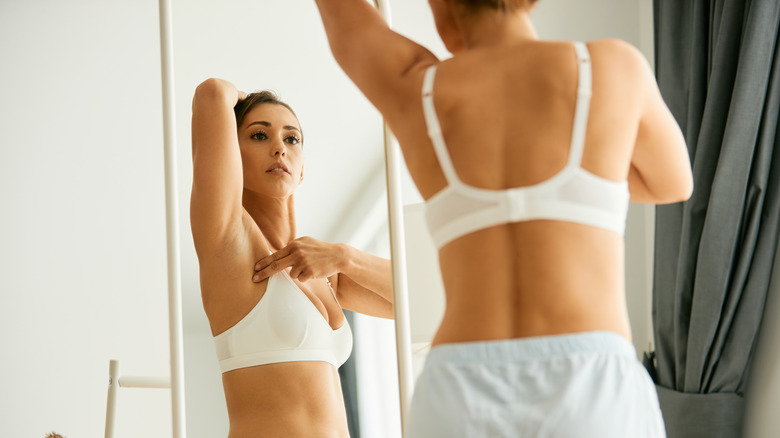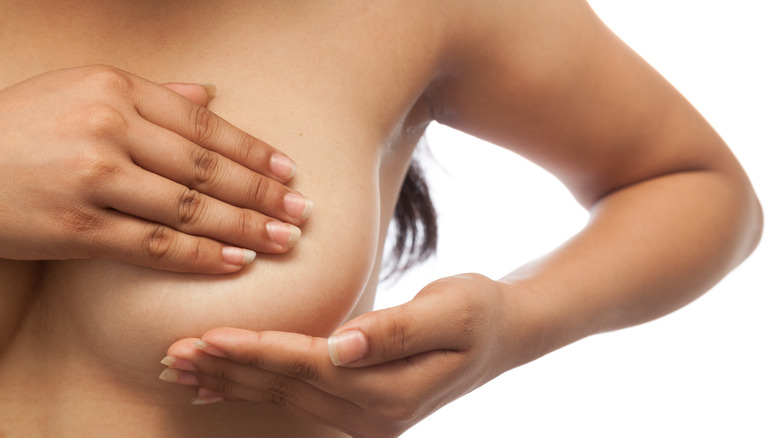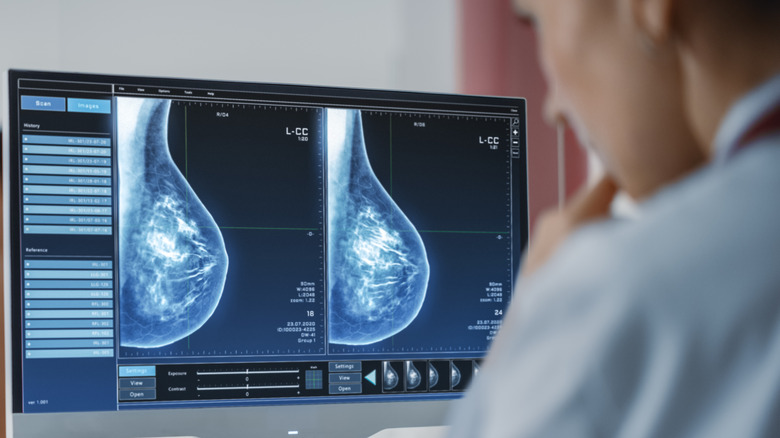Too Young For A Mammogram? Here's What You Can Do Instead
According to the Breast Cancer Research Foundation, around 264,000 women and 2,400 men are diagnosed with breast cancer in the United States each year. While these numbers may be alarming, it is important to note that the breast cancer survival rate has greatly increased over the past several decades. In fact, the number of deaths from breast cancer has decreased by an impressive 43% since the peak in 1989 (via Cancer.net). One major reason that the overall prognosis for those who have breast cancer has so greatly improved is because of increased screening and earlier detection.
Generally, for women without a personal or family history of breast cancer or other risk factors, beginning regular mammograms is advised between the ages of 40 and 50, depending on your doctor's personal recommendations. That said, just because you may be too young to begin regular mammogram screenings, you are never too young to begin taking smart steps to assess the health of your breasts.
While your OB-GYN likely does a breast exam at your annual well woman visit, you should feel empowered to take your breast health into your own hands, literally. Doing self breast exams can help you to become familiar with what your breasts feel like and look like so that you can notice more quickly if something seems to change or if something might be cause for alarm.
What to know about self breast exams
The Mayo Clinic states that the purpose of a self breast exam is to familiarize yourself with your own body so that you can be more aware of any changes that might occur or that might warrant a call to your doctor. While most changes in your breasts that you might discover during a self exam are likely to have benign causes, it is always a good idea to check with your doctor if anything seems unusual or suddenly uncomfortable.
If you menstruate, you'll want to choose a time in your cycle when your breasts are least tender and swollen to do a self-exam. In order to perform a self exam, first do a visual exam. That simply requires you to stand in front of a mirror, facing forward. You are looking for anything that looks different from usual, which could be a new lack of symmetry, puckering, dimpling, etc. Please note none of those things are necessarily cause for alarm, especially if they have always been there. The purpose of a visual exam is to check for changes. Do the visual exam with your hands pressed into your hips, with your arms raised over your head, and with your palms pressed together to see your breasts from different angles.
Next comes the physical portion of the exam.
What to know about the physical portion of a self exam
To perform the physical portion of the exam, you'll want to find somewhere comfortable to lie on your back, as when you are lying down, the tissue of your breasts spreads out, allowing you to feel things more acutely (via Mayo Clinic). Next, use the pads of your fingers to examine your entire breast, including below your collar bone, your underarm, and the bottom of your breasts where they meet your rib cage. The goal is to feel all layers of the breast tissue, so first examine with light pressure, which will allow you to feel the tissue just under the skin. Then follow with medium pressure, and then more firm pressure to feel deeper layers of tissue. If it helps, imagine the face of a clock over your breast and ensure you hit every number and every place from the rim of the clock to the center of the face.
Performing self exams can be anxiety-inducing for some, so remember that how often and how thoroughly you do a self exam is no one's choice but your own, and it is always okay to ask your doctor to perform an exam for you when you are in the office if you would rather not do it yourself.
If you do find something concerning during a self exam, or if you have a family history of breast cancer, your doctor may want you to be screened.
Types of breast cancer screening
It's possible that if you have a family history of breast cancer or a personal history of anomalies in your breast tissue, your doctor may want you to have a mammogram earlier than generally recommended for lower-risk individuals. And that's nothing to be afraid of; it simply means your are being proactive and responsible. The most likely method of screening your doctor might schedule is for a mammogram. If, however, you have dense breast tissue or your doctor feels a different type of screening might be more effective for your particular concern, there are non-mammogram options.
Ultrasounds and MRI of the breast are common tests that can be used in place of or in addition to mammography, depending on what your doctor feels is best for your particular situation (via Cancer.org). Further, there are new forms of breast cancer screening technology on the horizon, including 3-D mammography and breast tomosynthesis, both of which are already being used in some centers, though they are not yet mainstream.
The most important thing to remember is that you are empowered to be proactive where it comes to your breast health; becoming familiar with your own body is a wonderful first step. And never be afraid to contact your doctor if something is worrying you; your health and peace of mind are always worth it.



